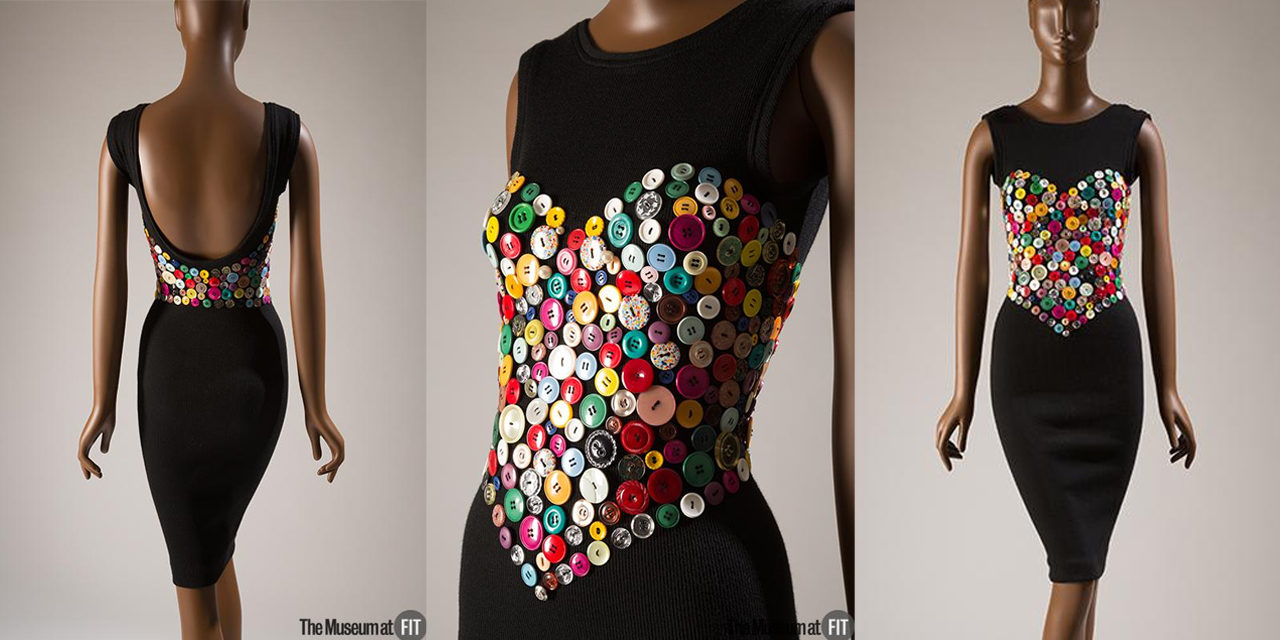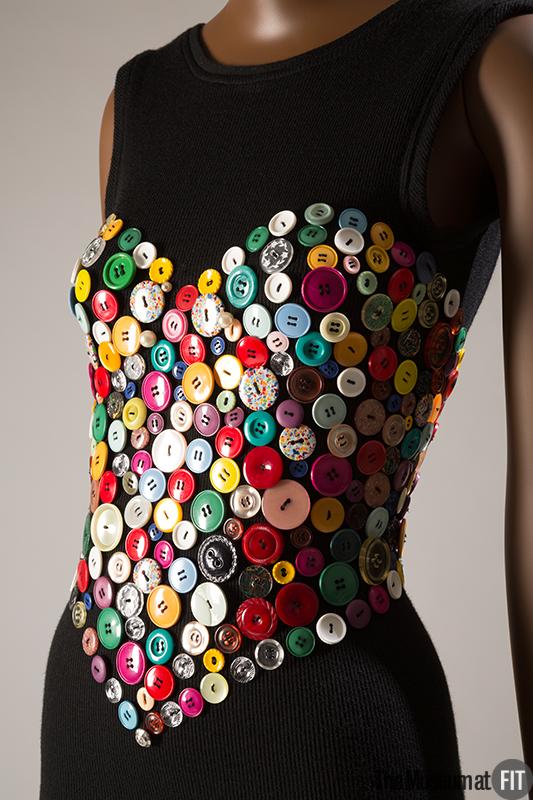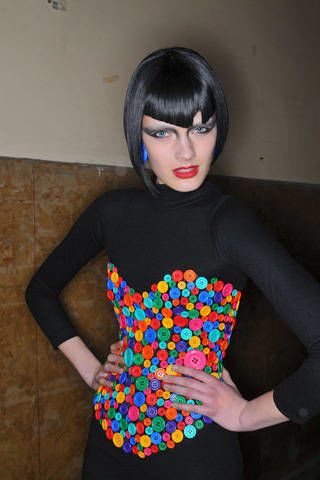Patrick Kelly is remembered for his skin-tight dresses, design affinity for buttons and hearts, and his joyous attitude — all which are manifested in this 1986 dress.
About the Look
This dress (Fig. 1) is a classic piece by fashion designer Patrick Kelly, bearing several of his best-remembered signature design features.
The dress belonged to Kelly’s Fall/Winter 1986 collection, and is currently in the collection of the Museum at the Fashion Institute of Technology.
Kelly was well-known for designing skin-tight, body-conscious dresses. The signature cling factor of his dresses was achieved by using a stretchy wool knit fabric. While Kelly regularly utilized many colors in his designs, this version was made in black. It is knee-length and sleeveless with a high scoop neckline and very low scoop back.
Of course, its most striking feature is its trompe-l’œil bustier of Kelly’s signature buttons (Fig. 2). Hundreds of colorful, mis-matched buttons were sewn onto the fabric to form the illusion of a bustier. The bustier’s rounded, sweet-heart cut and pointed waistline resemble the shape of a heart — yet another one of Kelly’s trademarks.
As Michelle McVicker explained in her designer profile on Kelly:
“Kelly’s signature use of playful buttons referenced the mismatched buttons his grandmother used to mend his family’s clothing.”
Fig. 1 - Patrick Kelly (American, 1954-1990). Dress, Fall 1986. Wool, plastic. New York: Museum at the Fashion Institute of Technology, 2016.48.1. Source: Museum at the Fashion Institute of Technology
Fig. 2 - Patrick Kelly (American, 1954-1990). Dress, Fall 1986. Wool, plastic. New York: Museum at the Fashion Institute of Technology, 2016.48.1. Source: Museum at the Fashion Institute of Technology
Patrick Kelly (American, 1954-1990). Dress, Fall 1986. Wool, plastic. New York: Museum at the Fashion Institute of Technology, 2016.48.1. Source: Museum at FIT
About the context
Patrick Kelly (Fig. 3) was born in 1954 in the southern state of Mississippi (“Patrick Kelly”). He was primarily raised by his mother and grandmother. Kelly recalled a defining moment around 1960, when his grandmother brought home a fashion magazine that included no depictions of African American women (“Patrick Kelly”). His grandmother explained that fashion designers did not design for African Americans. Only about six years old at the time, Kelly felt a desire to change that.
Indeed, Kelly’s passion for sewing and design began at an early age. Before even graduating high school, Kelly was sewing dresses for neighborhood girls, designing department store windows, and drawing for newspaper advertisements (“Patrick Kelly”). Then, after two years of studying art history and African American history, Kelly made the decision to leave school and pursue a career in fashion. His beginnings in the fashion industry were humble. First in Atlanta and then in New York City, Kelly worked odd jobs and sold his designs on the street.
Fig. 3 - Pl Gould. Patrick Kelly in Paris, ca. 1989. Getty Images. Source: Vice
Fig. 4 - Patrick Kelly (American, 1954-1990). Dress, Fall/Winter 1986–87. Wool, plastic, synthetic. New York: The Metropolitan Museum of Art, 2005.92. Gift of Elaine Blatt, 2005. Source: The Metropolitan Museum of Art
Fig. 5 - Patrick Kelly (American, 1954-1990). Dress and gloves, Fall/Winter 1986-87. Wool and plastic. Los Angeles: Fashion Institute of Design & Merchandising Museum. Gift of Steven & Linda Plochocki. Source: FIDM Museum Blog
Fig. 6 - Jim Smeal. Bette Davis wearing Patrick Kelly, 1988. WireImage. Source: The Guardian
Kelly’s career as a fashion designer finally took off once he moved to Paris in 1979. He made a name for himself working as a costume designer and continuing to sell his designs to friends and strangers. His growing reputation got him hired by an exclusive Paris boutique in 1984, and just one year later he and a friend formed their business, Patrick Kelly Paris (“Patrick Kelly”).
Much of Kelly’s design inspiration came from African American history. His pride in his heritage and African American culture was manifested in reclaiming design motifs like watermelons and Black baby dolls.
Kelly’s design affinity for colorful buttons were inspired by his personal history. He used them to pay homage to the grandmother who helped raise him. Due to the family’s financial struggles, Kelly’s grandmother used mis-matched buttons to mend his clothing. Kelly channeled this make do and mend spirit into creative inspiration.
In 1986, Women’s Wear Daily covered the latest European showings. While Yves Saint Laurent and Karl Lagerfeld stole the headlines, Kelly’s collection was also commented on:
“[Patrick Kelly is] sticking to his tight, sexy jersey tube dresses and sticking things on them — brightly colored buttons around the midriff or heart-shaped ones over the chest.” (“YSL Gets A Lively New Spirit.”)
While that excerpt perfectly described this particular dress at Museum at FIT, it can also be applied to other Kelly pieces from around that time.
The Metropolitan Museum of Art has a very similar dress which they have dated to Fall/Winter 1986–87 (Fig. 4). Unlike the Museum at FIT version, the Met dress has long sleeves and the button bustier has an even more pronounced heart shape. The Fashion Institute of Design & Merchandising Museum also possesses a similar long-sleeved dress with matching gauntlet-style gloves also covered in buttons (Fig. 5). Bette Davis, a fan of Kelly’s, can be seen in figure 6 wearing a black dress with buttons forming a heart over the chest, as Women’s Wear Daily had described.
By 1987, Kelly had achieved international success through a five million dollar contract with the apparel manufacturer Warnaco (“Patrick Kelly”). More major deals were soon to follow. In 1988, Kelly became the first American to join the Fédération française de la couture, du prêt-à-porter des couturiers et des créateurs de mode, becoming a part of the French ready-to-wear industry — alongside Chanel, Dior, and Yves Saint Laurent (Jacobs).
Kelly brought an unprecedented level of joy and fun to Paris fashion. In addition to his signature buttons, Kelly also utilized other playful adornments in his designs — including bows, dice, and picture frames (Fig. 7).
However, it seems that his buttons had the greatest impact on contemporary fashion. In May 1989, Seventeen wrote:
“Call us crazy, but we just love the comical, wildly eccentric style of Parisian designer Patrick Kelly. High fashion seemed sooo serious before he burst onto the scene a few years ago and single-handedly started the big button craze.” (“Designs on You.”)
Tragically, Patrick Kelly passed away in January of 1990 (Kirkby). While his obituary named his cause of death “bone-marrow disease and a brain tumor,” we now understand that Kelly passed away from AIDS-related complications (McVicker). His untimely death at the height of his career was a tremendous loss to the world.
Fig. 7 - Renee Valerie Cox (Jamaican-American, b. 1960). Models wearing dresses, button pins, and bows by Patrick Kelly. Seventeen, Vol. 46, Iss. 9, (Sep 1987): 192. Source: ProQuest
Its Afterlife
Patrick Kelly made a permanent mark on fashion, and his legacy lives on through designers he has inspired. In addition to being an incredibly creative mind, Kelly’s runway presentations were also innovative and ground-breaking. For example, in 1987 Kelly featured a runway model who was eight months pregnant (Johnson). This was replicated in 2018 by Rhianna for Savage x Fenty (Gonzales).
Jeremy Scott took direct inspiration from Patrick Kelly for his Fall/Winter 2009 collection. Scott sent several button-covered pieces down the runway. The skin-tight black dress pictured in figures 8 and 9 features a trompe-l’œil bustier composed of multi-colored buttons, evocative of the Kelly dress in the Museum at FIT.
Fig. 8 - Jeremy Scott (American, b. 1975). Jeremy Scott dress, runway photo, Fall/Winter 2009. Source: Elle
Fig. 9 - Jeremy Scott (American, b. 1975). Jeremy Scott dress, backstage photo, Fall/Winter 2009. Source: Elle
Fig. 10 - Eileen Costa (American). Dress exhibited at the Museum at the Fashion Institute of Technology, 2016. Source: Flickr
Fig. 11 - Brooklyn Museum. Dresses exhibited at "Patrick Kelly: A Retrospective", 2004. Source: Brooklyn Museum
Fig. 12 - Philadelphia Museum of Art. Dresses exhibited at "Patrick Kelly: Runway of Love", 2014. Source: Philadelphia Museum of Art
This dress was exhibited by the Museum at FIT in their 2016 exhibition “Black Fashion Designers” (Fig. 10). Dresses with similar adornments were exhibited at retrospective exhibitions of Kelly’s work, in 2004 at the Brooklyn Museum (Fig. 11) and 2014 at the Philadelphia Museum of Art (Fig. 12). Most recently, a very similar Patrick Kelly dress from fall/winter 1986–87 was exhibited at the Metropolitan Museum of Art in the 2021-2022 exhibition In America: A Lexicon of Fashion. In this exhibition, the dress was chosen to represent the word “Joy.”
References:
- “Black Fashion Designers.” Museum at the Fashion Institute of Technology. 2016. Accessed June 26, 2020. https://exhibitions.fitnyc.edu/black-fashion-designers/.
- Brooklyn Museum. “Patrick Kelly: A Retrospective.” 2004. Accessed July 31, 2020. https://www.brooklynmuseum.org/exhibitions/patrick_kelly.
- “Designs on You.” Seventeen 48, no. 5 (May 1989): 50, 206. https://libproxy.fitsuny.edu:2818/docview/1870590024?accountid=27253.
- Gonzales, Erica. “Pregnant Models Rocked Lingerie at Rihanna’s Savage X Fenty Show.” Harper’s Bazaar. September 13, 2018. Accessed July 31, 2020. https://www.harpersbazaar.com/fashion/models/a23109442/rihanna-savage-fenty-fashion-show-pregnant-models/.
Johnson, Bonnie. “In Paris, His Slinky Dresses Have Made Mississippi-Born Designer Patrick Kelly the New King of Cling.” PEOPLE.com. June 15, 1987. Accessed July 31, 2020. https://people.com/archive/in-paris-his-slinky-dresses-have-made-mississippi-born-designer-patrick-kelly-the-new-king-of-cling-vol-27-no-24/. - Kirkby, Marilyn. “Fashion Designer Patrick Kelly Dies — Paris-Based Industry Welcomed American Of Humor, Imagination.” The Seattle Times. January 3, 1990. Accessed July 28, 2020. https://archive.seattletimes.com/archive/?date=19900103&slug=1048926.
- McVicker, Michelle. “1954-1990 – Patrick Kelly.” Fashion History Timeline. July 13, 2020. Accessed July 28, 2020. https://fashionhistory.fitnyc.edu/1954-1990-patrick-kelly/.
- “Patrick Kelly.” In Encyclopedia of World Biography, 2nd ed., 273-275. Vol. 22. Detroit, MI: Gale, 2004. Gale eBooks (accessed July 27, 2020). https://libproxy.fitsuny.edu:2653/apps/doc/CX3404708062/GVRL?u=fitsuny&sid=GVRL&xid=777f2287.
- Philadelphia Museum of Art. “Patrick Kelly: Runway of Love.” Philadelphia Museum of Art. 2014. Accessed July 31, 2020. https://www.philamuseum.org/exhibitions/799.html.
- “YSL Gets A Lively New Spirit.” Women’s Wear Daily, Mar 27, 1986, 1-5, https://libproxy.fitsuny.edu:2818/docview/1445621099?accountid=27253.
- Jacobs, Laura. “A Designer With Heart.” The Wall Street Journal. April 30, 2014. Accessed July 28, 2020. https://www.wsj.com/articles/fashion-review-patrick-kelly-at-the-philadelphia-museum-of-art-1398888856.























